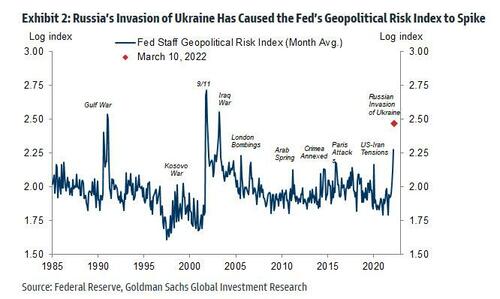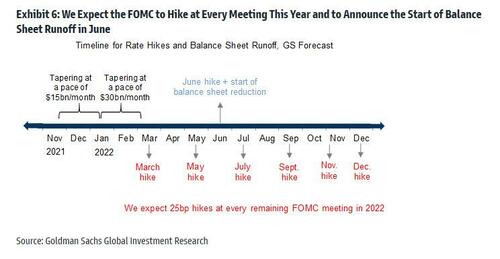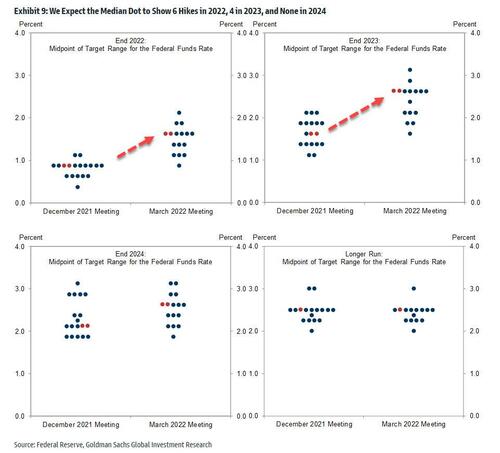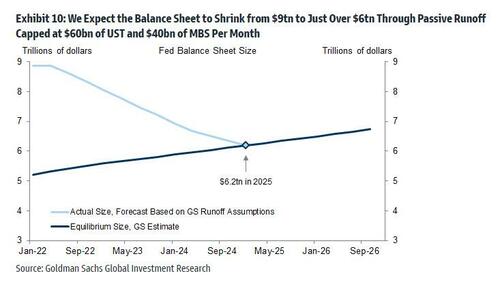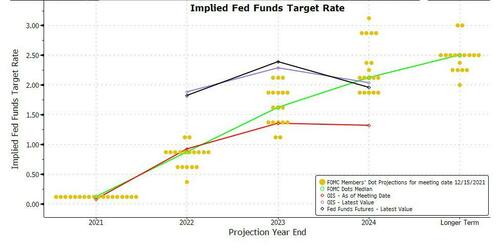FOMC Preview: The First Rate Hike Since 2018
Central banks face a challenging trade-off: do they react to the labor market close to full employment and near record jump in inflation visible even before the latest energy price moves to prevent a further unanchoring of inflation expectations to the upside, or do they react to the considerable downside risks to the economic outlook from a massive geopolitical and energy price shock, preferring not to add volatility to the current market environment. The ECB opted for the former, and the Fed is expected to follow suit.
Tomorrow the Fed will hike 25bps – its first rate hike since Dec 2018 and the first liftoff (from zero) since Dec. 2015. In his recent testimony to Congress, Chair Powell summed up the compromise that the FOMC appears to have reached by noting in his recent testimony to Congress that he will support a 25bp hike at the March meeting, but is open to hiking by more than 25bp at a future meeting if inflation surprises to the upside or remains persistently high.
To be sure, many will ask why just 25bps – after all, the last time inflation was 7.9%, the Fed Funds rate was 15%. The answer is that never before has the US financial system been so hyperfinancialized, and any “rushed” attempt to lift rates will lead to a complete collapse in risk assets.
The Fed will also update the Summary of Economic Projections (SEP) to show that inflation will remain higher for longer and result in hikes of 100-125bps in each of ’22 & ’23, even though markets are far more hawkish, and have priced in 7 rate hikes for all of 2022, and a 15% chance of a 50bps rate hike on Wednesday.
The Fed may also trim growth forecasts because of geopolitical risks. According to BofA’s Ralf Preusser, Powell will offer limited guidance on the outlook for hikes: he will stress elevated uncertainty, data dependency, & retain option for 50bp hikes if needed.
The 25bp vs. 50bp debate in the months ahead will also depend on the war in Ukraine. The war has raised energy prices, tightened financial conditions, and lowered growth prospects abroad, implying higher inflation and lower growth in the US. Goldman suspects that the FOMC will be reluctant to consider a 50bp hike until downside risks to the global economy from the war diminish.
While a rate hike is fully priced in, the market focus will be on the outlook for hikes and QT. In its FOMC preview, Goldman writes that it does not expect the war to knock the Fed off of a 25bp-per-meeting tightening path. With inflation likely to remain uncomfortably high all year, the FOMC will probably only pause if it thinks further tightening risks pushing the economy into recession. Goldman expects seven 25bp hikes this year – in line with the market – one at every meeting this year, followed by four quarterly hikes in 2023, for a total of 11 rate hikes by the end of 2023, and for a terminal rate of 2.75-3%.
Going down the SEP, the dots are likely to jump again in March, though the FOMC’s forecast will be less hawkish than the market’s. Even more hawkish than BofA, Goldman expects the median dot to show six hikes in 2022, but the risks are tilted to the downside, especially if FOMC participants view balance sheet reduction as equivalent to multiple rate hikes. In 2023, GS expects the median dot to show four more hikes in 2023 and a terminal rate of 2.5-2.75%, just above the FOMC’s 2.5% neutral rate estimate.
Goldman also believes that the FOMC will avoid appearing to commit to a specific pace of tightening in its statement. The Committee could adapt Powell’s recent comment, “We will use our policy tools as appropriate to prevent higher inflation from becoming entrenched while promoting a sustainable expansion and a strong labor market.”
An interesting question, according to Bank of America, is whether the latest evidence of liquidity pressure in the Treasury market is causing a rethink on timing and design of QT. On QT, the bank expects the Fed to finalize their redemption caps for UST coupons, MBS, & bills (BofA cap base case: UST coupons = $60b/m, MBS = $40b/m, bills = no cap); these will likely be updated in the Fed’s “principles for reducing balance sheet” document.
BofA believes that QT details will be finalized at this meeting and allow the Fed to start QT as early as May, however, QT risks being delayed due to deteriorating UST liquidity and a Fed that does not want to add market uncertainty. According to the bank, there are risks that QT could get pushed to June or July; and may also start with only MBS QT if UST liquidity remains strained. “A later QT start could add to curve flattening pressures”, BofA warns.
Goldman does not believe that the Fed will rush QT and reminds clients that Powell said in his testimony to Congress that the FOMC will not finalize its plan to shrink the Fed’s balance sheet at the March meeting. Instead, the FOMC will likely finalize and publish its plan at the May meeting and then announce the start of balance sheet reduction at the June meeting.
That said, where Goldman does agree with BofA is in the expectation of how much QT will be once it does begin: the bank expects the FOMC to permit passive runoff capped at $60bn per month for US Treasury securities (UST) and $40bn per month for mortgage-backed securities (MBS), with at most a brief ramp-up period to reach those peak rates. Some Fed officials have also raised the possibility of permitting uncapped runoff of MBS. This would have almost no incremental impact on runoff relative to the $40bn per month cap but it might seem like an agreeable compromise to participants who had advocated sales of MBS. Comments from Fed officials suggest that the FOMC has also discussed the possibility of treating bills separately from other Treasury securities and letting them run off more quickly.
In sum, Goldman’s assumptions imply that the balance sheet will ultimately shrink from just under $9tn today to just over $6tn in 2025, although since a recession will hit long before then, this estimate appears at best naive.
A more detailed FOMC preview is below, courtesy of Newsquawk
The Fed Funds target range is expected to be lifted by 25bps in the first hike since COVID-19 with inflation running hot and the labor market widely considered close to full employment. The accompanying SEPs are expected to signal a string of hikes to follow this year in wake of ramped inflation forecasts, countered with lower growth forecasts. The guidance will be gauged to see whether FOMC is moving towards the market pricing of front-loaded hikes (seven this year), or a more measured three/four hikes. The uncertainty around the Ukraine invasion has pushed back on the chances of 50bps hikes, but the door is still open. Powell could provide more details around balance sheet reduction, but plans/launch are not to be finalised until mid-2022.
HIKE INCREMENT: The majority of Fed officials have come out in support of a 25bps liftoff for the Federal Funds target range, particularly in wake of the Ukraine uncertainty. Fed Chair Powell said in his testimony in the Capitol that he thinks it is appropriate to hike by 25bps in March. Although he warned if inflation doesn’t begin to come down, “we’re prepared to raise by more than that amount in a meeting or meetings”, keeping the door open on 50bps in future meetings. A Reuters poll of economists saw all respondents forecast a 25bps hike, while 20/37 economists saw the risk of a 50bps hike later this year as high or very high. Rates markets are implying a 5% chance of a 50bps liftoff. On administered rates, the majority expect the IOR (currently 0.15%) and RRP (currently 0.05%) to both be hiked by the same 25bps increment with money markets having been stable and the effective Federal Funds rate comfortably within the target range.
RATE PATH: Bloomberg’s survey has 28% of economists seeing the March statement indicating a hike in May, 45% expect signalling for a string of increases, and 28% see no forward guidance in the statement. Meanwhile, the Dot Plot is expected to signal more hikes are to follow this year in the Fed’s efforts to get the Fed Funds closer to neutral (largely seen at 2.5%). Powell has said that every meeting is live for 2022, but the broader discourse has seen a binomial outlook develop, with one camp leaning towards three/four hikes while the other leans towards the mid-to-high single digits, corroborating with market pricing. On which, after a Ukraine-induced unwind in market hike pricing in early March, rates markets are now back to pricing seven 25bps hikes by year-end, supported recently by the hawkish ECB and given the Fed has been undeterred in its policy outlook in wake of the invasion. The cooling of market volatility has helped.
BALANCE SHEET: Powell has said balance sheet normalisation/reduction plans will not be finalised at the March FOMC but will occur some time after the initial rate lift off. Little new details have been touted by officials in wake of the announcement made at the January confab either, where the Fed released its Principles for Reducing the Size of the Federal Reserve’s Balance Sheet. Powell may use the upcoming FOMC to give a calendar guide to when the process will begin, where expectations range largely for the rolloff to begin between July and September. And potentially on pace and composition, with Bloomberg’s median survey of economist estimates seeing the balance sheet at USD 8.5tln by 2022-end compared to the current USD 9tln area, and another USD 1tln reduction is expected in 2023. Meanwhile, amid some calls for faster MBS roll-off, most economists don’t expect a faster relative pace of MBS vs Treasuries reduction to begin with, although the Fed has kept the door open to that possibility going ahead, with some officials touting potential outright sales, instead of the current rolloff plans.
FINANCIAL CONDITIONS: A big part of the argument for 25bps liftoff instead of 50bps is the already realised deterioration in financial conditions, tightening the flow of credit to the economy. Goldman Sachs’ Global Financial Conditions index hit its tightest since May 2009, tightening 130bps since the Ukraine invasion, and adding to the increased certainty of central bank tightening paths that were already beginning to affect conditions beforehand. That tightening has been accentuated by a spell of funding pressures amid the market volatility, seen in lower stocks and record-breaking commodity strength, playing into credit spread widening. Note the recent cooling of those pressures, however. Albeit, the market is already tightening and the Fed now needs to ratify those expectations with its liftoff, but there’s less urgency to surprise too hawkishly.
INFLATION: Headline Feb CPI rose 7.9% Y/Y, with the core not far behind at +6.4% as price pressures become more broad based. Figures were in line with the Wall St consensus and presumably a slight sigh of relief for policymakers that there wasn’t another right tail print, albeit still at alarming levels. Further, given the approaching commodity shock, the Fed will now be viewing the figures as a base to grow off/sustain, rather than a peak that was expected before the Ukraine invasion. Even after the Feb NFP saw signs of cooling wage growth and easing price spiral fears, it’s noteworthy Fed’s Evans (non-voter; last speaker ahead of FOMC blackout) on CNBC said the report didn’t change much for the Fed and took the time to warn about further approaching inflation, with particular concern around food prices. Indeed, the Feb CPI report saw food prices rise 1% M/M, the largest since the early COVID period, with risks skewed to the upside ahead given the rally in ags. And that’s not to mention the already lofty 3.5% spike in energy M/M, and over 25% rise Y/Y. The Fed has largely kept a cool head to look through the inflation, with the party line being the anchoring of longer term inflation expectations keeping credence to the idea that the pressures will recede. However, the recent breakout of market-based, longer-term inflation expectations post-Ukraine will be raising eyebrows and emboldening tightening plans, with 5yr5yr CPI swaps rising further towards their 2013/14 peaks of 3% and away from their 2% target.
DOTS: Bloomberg’s economist survey sees the FOMC raising its PCE forecasts for 2022 to a 3.9% median from 2.6% in December, cutting its 2022 GDP median to 3.3% from 4.0%, while maintaining the unemployment median at 3.5% for the next several years, according to the survey. Median dot expectations via Bloomberg’s survey:
- FEDERAL FUNDS RATE: exp. at 1.1% in 2022 (prev. 0.9% in Dec), 1.9% in 2023 (prev. 1.6%), 2.38% in 2024 (prev. 2.1%), 2.5% in longer run (prev. 2.5%)
- CHANGE IN REAL GDP: exp. at 3.3% in 2022 (prev. 4.0% in Dec), 2.2% in 2023 (prev. 2.2%), 2.0% in 2024 (prev. 2.0%), 1.8% in longer run (prev. 1.8%)
- UNEMPLOYMENT RATE: exp. at 3.5% in 2022 (prev. 3.5% in Dec), 3.5% in 2023 (prev. 3.5%), 3.5% in 2024 (prev. 3.5%), 3.5% in longer run (prev. 4.0%)
- PCE INFLATION: exp. at 3.9% in 2022 (prev. 2.6% in Dec), 2.5% in 2023 (prev. 2.3%), 2.1% in 2024 (prev. 2.1%), 2.0% in longer run (prev. 2.0%)
- CORE PCE INFLATION: exp. at 3.3% in 2022 (prev. 2.7% in Dec), 2.4% in 2023 (prev. 2.3%), 2.1% in 2024 (prev. 2.1%)
Tyler Durden
Tue, 03/15/2022 – 21:40
via ZeroHedge News https://ift.tt/PyrxBYv Tyler Durden
